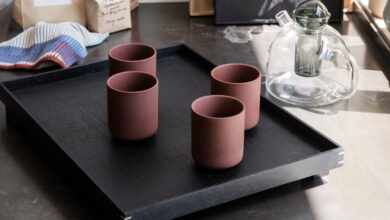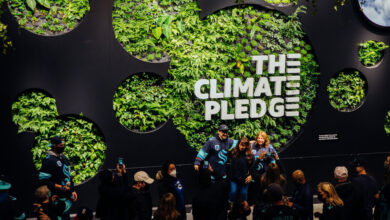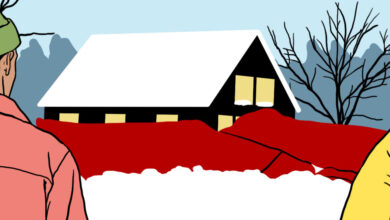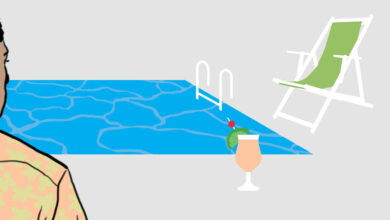Why Some of Your Annuals Should Be Native Plants
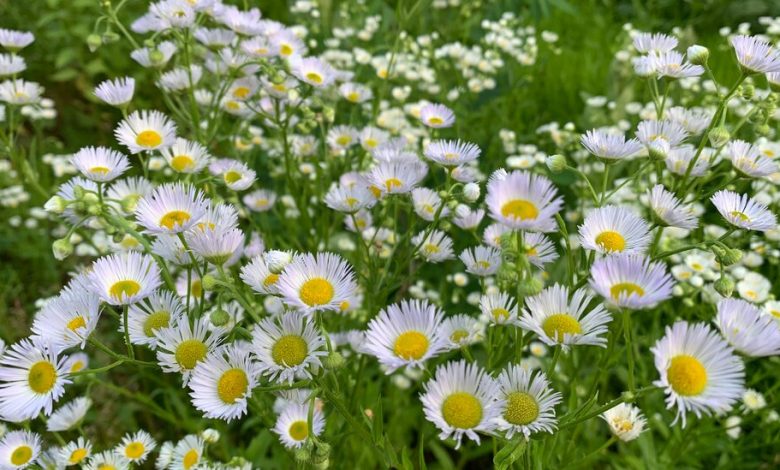
[ad_1]
There it was, as flashy as in the seed-catalog photos: three-foot-tall Euphorbia marginata, the striking green-and-white variegated spurge known as snow on the mountain.
But then Alan Branhagen did a double take. What was it doing in a prairie in western Iowa?
“And I was like, ‘Oh, it’s native,’” recalled Mr. Branhagen, who was doing fieldwork that summer as a college intern with the Nature Conservancy.
Suddenly, what he was seeing registered: an annual commonly associated with gardens, growing where there was no garden, but in a vast, wild place. A native plant, making itself at home.
It was perhaps his first native-annual aha moment. Since then, Mr. Branhagen, a lifelong naturalist who is the director of operations at the 1,200-acre Minnesota Landscape Arboretum, has encountered many other native annuals in situ.
He has heard stories about them, too — recounted by those like the turkey hunter who found himself in a spring woodland carpeted with blue-eyed Mary (Collinsia verna) and was so overcome that he had to sit down to take it all in.
Mr. Branhagen has also championed Midwestern prairie natives — as well as irresistible species from other regions — for use in gardens. Like the displays at Powell Gardens, near Kansas City, Mo., where Mr. Branhagen was the director of horticulture, and at the arboretum in suburban Minneapolis, where he works now.
The arboretum, which is part of the University of Minnesota, has a strong conservation mandate and is responsible for the oldest prairie restoration in the state. So even in the most traditional display gardens of perennials and bulbs, self-sowing native annuals like the Euphorbia are encouraged.
A Role as ‘Earth Healers’
Mr. Branhagen has published two books on regional natives, including “Native Plants of the Midwest: A Comprehensive Guide to the Best 500 Species for the Garden,” which includes a section on annual species.
Say the word “annuals” to most gardeners and it suggests plants of subtropical ancestry that serve as the workhorses of summer pots and beds: the petunias, begonias and marigolds that go and go in the warmest months in our temperate gardens.
Native annuals, however, do so much more than provide summer color. As Mr. Branhagen put it, “Annuals are earth healers.”
In a natural system like a grassland or woodland, he explained, annual species are called upon to play a critical first-responder sort of role. “When a badger digs a hole in a prairie or some larger disturbance occurs,” he said, “they fill in all those gaps, becoming the first layer of succession.”
Annuals to the rescue, covering ground. No surprise, then, that while you’re transforming your lawn with native ground covers or waiting for a new meadow to fill in, annuals like partridge pea (Chamaecrista fasciculata) or black-eyed Susan (Rudbeckia hirta) make great filler, as a cover crop or nurse crop. And while they hold space for the perennials to size up, they support the food web — and look beautiful doing it.
At Powell Gardens, lemon bergamot (Monarda citriodora), an annual beebalm relative with purple flowers and bracts stacked in tiers, and Plains coreopsis (Coreopsis tinctoria) are used as placeholders, too.
“For the gardener, they provide instant gratification,” Mr. Branhagen said. “And everyone can see that you’re trying to do something, too.”
Fleabane, Jewelweed and More
Here’s the tricky part: Most of us cannot name many annuals native to the regions where we garden. So there is homework required — online and outdoors.
Most native annuals are not the stuff of mainstream seed catalogs. But the Lady Bird Johnson Wildflower Center’s website, Wildflower.org, allows you to filter native plant lists by state and then by life span (checking annual, biennial or perennial).
Some native plant organizations (find one near you) have searchable plant databases that can help. Calscape, the website of the California Native Plant Society, is one example.
And some native annuals may find you. Spotted jewelweed (Impatiens capensis), with its orange flowers, and daisy fleabane (Erigeron annuus) are two familiar examples, present in more than 40 states and much of southern Canada, according to Wildflower.org.
Yes, they are among those whose volunteer seedlings we often yank from our gardens, regarding them as weeds. It’s an impulse that Mr. Branhagen suggests we reconsider. Couldn’t we allow them at least a little real estate?
For “anyone who gardens and disturbs the earth in eastern North America, the annual fleabane is going to come up,” he said with a laugh. “And I get people asking, ‘Should I tear that out?’”
He counters by touting the appeal of its diminutive, yellow-centered daisies, a summer treat for beneficial insects.
Consider using a gentler hand around native Impatiens, too — the orange one and also the yellow-flowered, pale jewelweed (Impatiens pallida).
It’s all right to edit; both species are prolific self-seeders in shady, moist spots. But don’t eradicate them. Maybe identify a garden area or two where the plants can be allowed to seed in. And then watch.
“In the late summer, migrating hummingbirds will stake out their territory around orange jewelweed, as if it were a hummingbird feeder,” Mr. Branhagen said. The yellow species is particularly attractive to native bumblebees.
You may have mistaken the wild cucumber vine (Echinocystis lobata) for a weed, as well — or even an invasive — and rushed to pull it. Maybe you don’t want it scrambling up every shrub as it does in roadside hedgerows, especially at the edge of damp woods or streams. But how about allowing it to cover a fence in the summer?
The vine has cucumber-like foliage and frothy little white flowers followed by what look like tiny, spiny cucumbers. And it deserves more use in the garden, said Ulrich Lorimer, the director of horticulture at Native Plant Trust, in Massachusetts, who featured it in “The Northeast Native Plant Primer: 235 Plants for an Earth-Friendly Garden.” (Mr. Branhagen wrote the Midwest volume of that regional primer series.)
Bigger, Bolder Daisy Relatives
Not all the annual daisy relatives send up tiny flowers like fleabane’s.
The common sunflower (Helianthus annuus) is an American classic. The way nature made it was not like the domesticated cultivars with fewer, larger flowers. Instead, it is multibranching, with many smaller blooms — each of which makes a great cut flower, Mr. Branhagen said.
Then there’s the well-known black-eyed Susan, which is even more wide-ranging than jewelweed or fleabane and may behave like a biennial or short-lived perennial in some climates.
Sneezeweed (Helenium amarum) has vivid yellow flowers on bushy, foot-tall plants with distinctive threadlike foliage. It’s a candidate for hugging the edge of paths and other gravelly spots, or even for a rock garden, Mr. Branhagen said. This one has made its way into catalogs, as the cultivar Dakota Gold.
Lately, Mr. Branhagen has also been pleased to see American basket-flower (Centaurea americana) showing up in catalogs like Select Seeds and Seed Savers Exchange. While it’s more common in South Central states, it’s a species that he grows and highly recommends.
Because it does not reliably self-sow for him year to year, Mr. Branhagen starts seedlings indoors, to plug in between perennials at his 2.4-acre home garden. The fuzzy, four-inch lavender flowers (a white selection is now available, too) have a honey scent, and their faded seed heads also look good in the off-season, he said.
Hungry goldfinches agree. And earlier in the year, the plant catches the attention of all manner of pollinators, from butterflies to bees.
Not Native Here, But Irresistible
Like that snow on the mountain, there are annuals from other regions of the United States that many of us can’t help but covet.
And no wonder, if the mental image we conjure is of a plant like California poppy (Eschscholzia californica). Or a whole bed of them — which Mr. Branhagen creates by sprinkling the seeds into the last Minnesota snow each winter, in anticipation of the vivid orange summer blooms.
Another annual he would not be without — native range maps notwithstanding — is the California bluebell (Phacelia campanularia), whose seeds he also sows then.
Every year, he looks forward to the self-sowing, hot-colored blanket flower Gaillardia pulchella, which ranges into Mexico.
And Palafoxia (P. callosa), native from the Ozarks into Texas — a haze of little lavender blooms more often seen in railroad rights of way and other rocky spots than in American gardens, where it is unfortunately little known, Mr. Branhagen said.
The silverleaf sunflower (Helianthus argophyllus) may not be native where you live (unless you’re in South Texas or parts of North Carolina and Florida). But what a glorious garden plant it makes, with its silvery-gray, multibranched structure supporting lots of gold flowers.
And what if you have your own little piece of hell, a spot so hot and dry that nothing wants to grow there? Consider Leavenworth Eryngium (E. leavenworthii), from the rocky, fast-draining prairies of the Southern Great Plains.
“It is just so shockingly beautiful, with flowers that look like metallic-blue pineapples,” Mr. Branhagen said. “If you’re planting a hell strip with all this heat and radiation off buildings and streets or rocks, it would just be so happy. And people would probably be, too, to get to see it.”
Margaret Roach is the creator of the website and podcast A Way to Garden, and a book of the same name.
For weekly email updates on residential real estate news, sign up here. Follow us on Twitter: @nytrealestate.
[ad_2]
Source link


